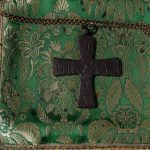Small Artefacts And Icons
The precious small works of art of the Monastery include a wooden diptych (from the end of the 13th century-beginning of the 14th) with 26 small portraits of the twelve Apostles, the four Evangelists, and other saints, and a portable wooden shrine icon, with a rare glass depiction of Christ Enthroned, together with the Prayer (i.e. the Δέηση, with the Virgin Mary, St John, and two archangels) set in a metal frame decorated with busts of the saints, a valuable work of a Venetian workshop dated to the end of the 13th century. Another small but impressive artefact is a wooden cross with carved depictions of the twelve Apostles, set in a brass base with Arabic inscriptions.
Apart from the sacred relics and the precious small artefacts, the St Pavlos Monastery has a very significant and valuable collection of Byzantine portable icons dating from the 12th century, and many to the later Byzantine-Palaiologian period. The oldest of these, a small icon of the Virgin Mary known as The Mirror («Καθρέφτης»), dates to the iconoclastic period. According to the Monastery tradition, it is said to have belonged to the Empress Theodora, the wife of Theofilos, who hid it behind the mirror in her bedroom, thereby giving that name to the icon. Its stylistic and iconographic details place it at the end of the 12th century.
Another icon, a double-sided one with the Virgin Mary, the Guide, bears the inscription ‘MOST BLESSED’ on the one side, and the Host of Archangels on the other, is dated to the end of the 13th century and attributed to an artistic workshop of Thessaloniki. It is considered an excellent example of the renascence of the Palaiologians.
Five icons survive from the second half of the 14th century: The icon of the Virgin Mary of the Sweet Kiss (Γλυκοφιλούσας, Glykofilousas), the so-called ‘Nisiotissa’ or ‘Mesonisiotissa’, the icon of St Georgios, The Virgin Mary, the Guide (known as «Φυλάττουσας» Filattousas, the Guardian), the two-sided icon with the Virgin Mary, the Guide on one side and the Crucifixion on the other, and the icon of the Virgin Mary the Merciful (Ελεούσας, Eleousas). All are works of high quality which were created in the workshops of artists in Konstantinople and Thessaloniki. In addition, the Monastery has a large number of icons (dated from the 15th-19th centuries) from icon screens and others used for veneration during religious events. All of these have very interesting stylistic and iconographic characteristics which reflect the influence of the Cretan style as it was interpreted by the artists in Moldovlachian workshops and by local artists.

